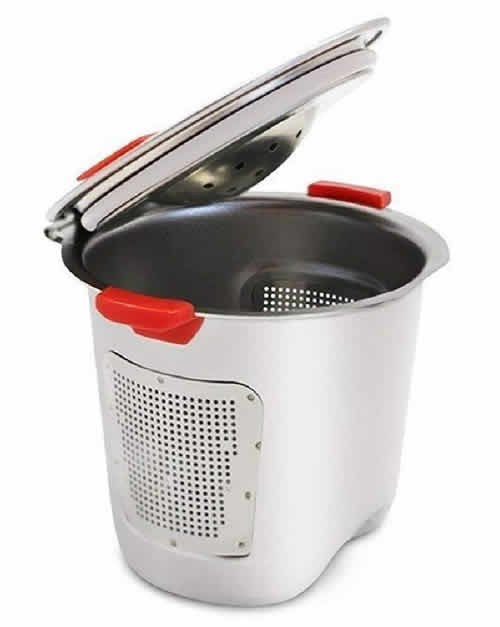How to Get Plastic Taste Out of New Keurig
If you're here because of Keurig plastic taste, you're in the right place! If your Keurig has stopped brewing, I have some suggestions on how to fix that.
So anyway, I wrote a whole thing about how to remove plastic taste from coffee makers in general (read it here), and most of that stuff actually does apply to Keurigs as well. Vinegar is probably the most common solution to plastic taste woes, but it doesn't work for everyone.
I've done some digging, and there are a couple of solutions that might succeed where vinegar fails. Still, we're going to start with the most basic fixes first (including vinegar), and then we'll look at a couple of other options that your googling may not have revealed yet.
But first, a disclaimer: If you do anything suggested on this page and your Keurig suddenly breaks, that's on you! Not me. I find this scenario unlikely, but it's your coffee maker. You make the decisions on what you're willing to do to it. Hence, I now pre-declare "don't look at me" in the event of any Keurig breakage.
Solution #1: Run a couple of reservoir's worth of hot water through the machine

Here's what you do:
- First, wash your water reservoir with warm, soapy water. Wash it thoroughly, inside and out, and rinse it clean.
- Fill the reservoir with water up to the "fill" line.
- Set your Keurig to the highest temperature setting if your coffee maker has that feature.
- Without using a K-cup, run enough brew cycles to empty at least one or two full reservoirs of clean water through the machine.
I know this "fix" might seem like it's hardly worth trying, but some folks out there on the Interwebs have actually reported success with this technique.
I think it would be reasonable to theorize that simply rinsing the machine out could remove any residue lurking inside the machine from the manufacturing process. Also, washing the reservoir of any residue or chemicals certainly can't hurt.
Yes, you've already run water through your Keurig in the process of making coffee. But if your first cup tasted like plastic, how many more did you brew? Flush that thing out and see what happens.
Solution #2: Run vinegar through your Keurig
This is easily the most common method of attempting to remove the plastic taste from a Keurig. As of today, if you google "Keurig plastic taste," Google presents you with a video where some guy basically just says, "put vinegar in your Keurig." I'll include that video at the end of this section just for fun.
The vinegar rinse will work for some, but not for everyone. Why? I'm not sure, but my personal theory is that some people are more susceptible to tasting certain chemicals than others. If your tastebuds are hyper-sensitive to plastic taste, you may need to do more than just run vinegar through your Keurig.
Mr. Millennial in the video down below also mentions that plastic taste occurs in newer Keurigs. Well … yeah! Doy. The reason for that is "outgassing" which is when the plastic parts of the coffee maker release gases that formed in the plastic during manufacturing.
According to the outgassing theory (which not everyone is onboard with), a Keurig that rolls off the assembly line today will produce a stronger plastic taste than one that's been sitting on a shelf for a while. Outgassing occurs over time, you see. And those gases get into the water that becomes your coffee.
Anyway, when it comes to vinegar, you have a decision to make. How much vinegar do you want to use?
Depending on your level of patience and how much vinegar is in your kitchen right now, you may want to go for a run of straight, undiluted distilled white vinegar. This is the most "aggressive" approach, as far as vinegar goes, and it will take more water to flush the vinegar taste out.

If you prefer to be more cautious, start with a 50/50 dilution of distilled white vinegar and water. If you notice that your Keurig is producing less-plasticky coffee, but still plasticky nonetheless, try again with a stronger dilution or no dilution at all.
Here's what you do:
- First, wash your water reservoir with warm, soapy water. Wash it thoroughly, inside and out, and rinse it clean. This is something you should be doing regularly, anyway.
- Remove the charcoal water filter.
- Fill the reservoir to the "fill" line with your preferred mix of distilled white vinegar (Amazon link) and water, or just straight vinegar if you're going balls out.
- Set your Keurig to the highest temperature setting if your coffee maker has that feature.
- After running enough brew cycles to empty the reservoir (no K-cup, of course), repeat with water only. Run water-only brew cycles until you can no longer taste the vinegar.
Did that fix it? No? Keep reading.
Solution #3: Buy a reusable stainless steel K-cup
If you love your plastic K-cups and are heavily invested in one of those K-cup organizers, sorry not sorry. It's true that K-cups are now recyclable, and that's great, but using less plastic is generally a good practice if you can manage it.
Plus, bonus! Your reusable K-cup will save you money in the long run because you'll be filling it with coffee that you buy by the pound. I suppose you could still rip open a K-cup and pour it into the reusable stainless steel K-cup, but that just seems silly.
The reason the stainless steel K-cup might kill the plastic taste is that you're taking a very important piece of plastic out of the equation: the plastic K-cup!

I have written volumes about the evils of plastic in the coffee-making process. Plastic leaches into water. Where that leaching occurs is still up for debate, but if the water rinse didn't work, and if the vinegar rinse didn't work, removing the plastic K-cup would seem to be the next logical step.
A quick search for "plastic taste" in the Amazon reviews for the stainless steel K-cup pictured above (Amazon link) reveals a whole bunch of people who say that it has improved the taste of their Keurig coffee.
Admittedly, only one person has explicitly stated that their plastic taste problem went away thanks to this stainless steel K-cup, but that's at least encouraging if nothing else.
To quote that one Amazon reviewer ("American Pie"):
Plastic k-cuptaste is gone!
Give it a try. You've really got nothing to lose.
Solution #4: Run food-grade activated charcoal through your Keurig
So far, I have seen this solution suggested by precisely one person on the internet, and it was in a YouTube comment from a lovely gem named Jennifer Carducci. Here's what she had to say:
About 3/4 tsp food grade activated charcoal works perfectly. Just added it to warm water, put it in the reservoir and the smell was gone on the first pass through. I ran it through a few more times just to be sure.
Notice that she said smell, not taste. But she wrote that comment in the comment section of the Vinegar + Keurig video above. You know, the one where Mr. Millennial is inexplicably floating in abstract white space while he discusses plastic taste in Keurigs. I guess we just have to hope for the best here.
At this point, you may be wondering what "activated charcoal" really is and why it might work.
According to WebMD (link), activated charcoal is made by heating common charcoal in the presence of a gas that causes the charcoal to form pores, a.k.a. little holes. Then those pores serve to somehow "trap" chemicals and prevent them from being absorbed by the body or, in this case, your Keurig.
Ok, this sounds pretty plausible. After all, plenty of coffee makers (notably, those made by Mr. Coffee, Cuisinart, and Keurig) already have built-in charcoal filters that are meant to improve the taste of your coffee. But if your Keurig already has a charcoal filter, why run a diluted mix of activated charcoal through it?

I suppose we can theorize that the charcoal filter in your Keurig is designed to filter the water from your reservoir only. That's where the filter lives, so it's not going to work its magic on the inside of the machine.
Perhaps running activated charcoal through your Keurig is an effective way of removing chemical compounds that live in your Keurig's rubber tubing?
All I can tell you is that it worked for Jennifer Carducci. I don't know Jennifer, but I don't see why she (or anyone) would make up such a wild tale if it weren't at least partially true.
So, based on Ms. Carducci's sage advice, here's what I assume you should do:
- First, wash your water reservoir with warm, soapy water. Wash it thoroughly, inside and out, and rinse it clean. This is something you should be doing regularly, anyway.
- Remove the charcoal water filter. Filtering the charcoal out of your water with a charcoal filter sounds pretty counterproductive.
- Fill the reservoir to the "fill" line with warm water.
- Add 3/4 tsp. of activated charcoal (Amazon link) to the water and mix it well.
- Set your Keurig to the LOWEST temperature setting if you have this feature. Google tells me that higher water temperature can decrease the effectiveness ("adsorption rate") of activated charcoal.
- Run enough brew cycles (no K-cup) to empty the reservoir.
- Run clean water through the machine and see how it tastes. Repeat the charcoal water rinse if necessary.
I guess it's also worth noting that you could increase the dilution of activated charcoal if your Keurig plastic taste persists. I don't see why this would have any negative effects on your Keurig's ability to function, but remember my disclaimer from above!
Conclusion
Plastic taste, whether it's in your Keurig or any other coffee maker, seems like a problem that's going to plague any coffee maker that's manufactured with plastic parts.
We can debate the causes and solutions until we're blue in the face, but what's important is that we find solutions and SHARE them! Of course, what works for you may not work for your neighbor (that's the fun of the plastic taste mystery), but sharing truly is caring.
And who knows, maybe the story of your success will help solve someone else's problem, too.
Have any of the Keurig plastic taste fixes above worked for you? Or maybe you did something different that solved your plastic taste problem? Please be a pal and share your story in the comment box below!
I moderate comments because of evil spammers, but all non-spammy comments will be approved as soon as I see them.
(Visited 17,481 times, 36 visits today)
How to Get Plastic Taste Out of New Keurig
Source: https://buydontbuy.net/2019/02/12/how-to-remove-plastic-taste-from-keurig/
0 Response to "How to Get Plastic Taste Out of New Keurig"
Post a Comment